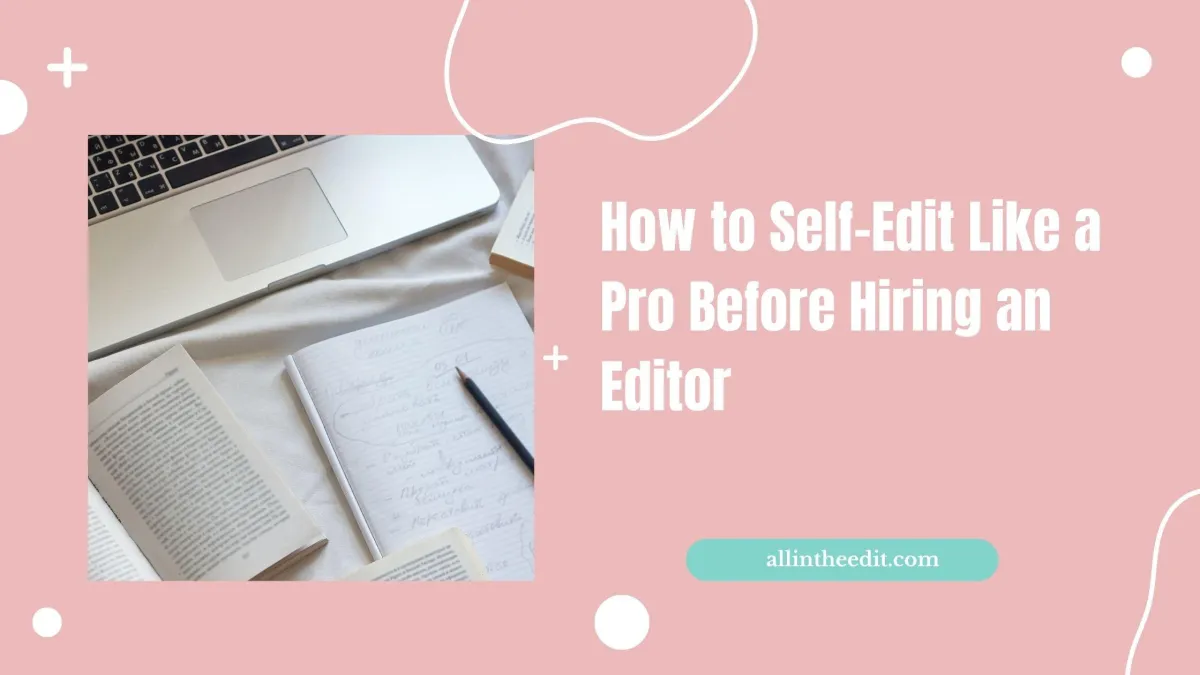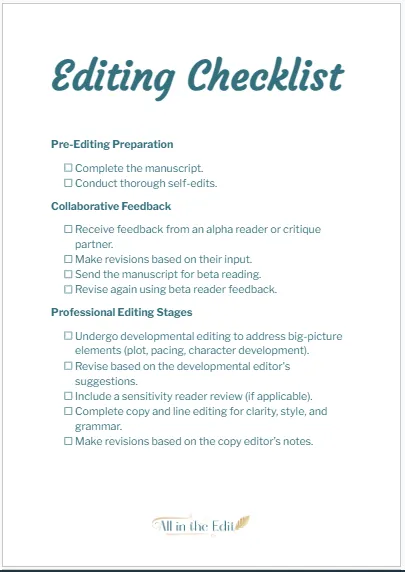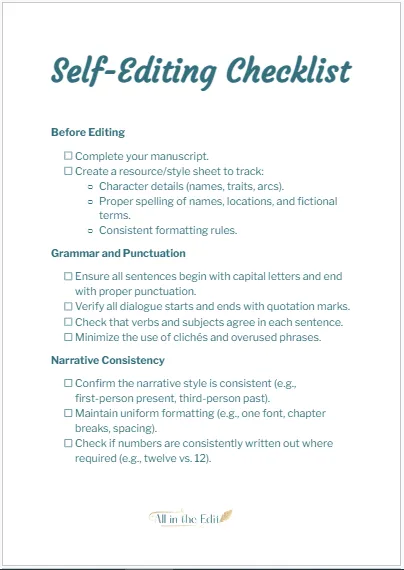
How to Self-Edit Like a Pro Before Hiring an Editor
Introduction
You’ve typed “The End”—but the work isn’t over yet. Whether you're preparing to publish independently or seeking traditional representation, self-editing your manuscript before handing it off to a professional editor is a crucial step in the writing process.
At All in the Edit, we work with authors at all stages of their publishing journey. One of the best ways to get the most value out of professional editing is to first go through a thorough self-editing phase. This allows you to clean up your manuscript, clarify your ideas, and present your best work—so your editor can focus on elevating your book even further.
In this post, we’ll walk you through how to self-edit like a pro, with practical, actionable steps you can start using right away.

Why Self-Editing Matters
Self-editing isn’t about doing the editor’s job—it’s about making their job more effective. Think of it this way: would you rather pay someone to fix messy typos and inconsistencies, or to elevate your narrative, refine your voice, and help shape your story?
By self-editing before hiring a professional editor, you:
Save time and money in the editing process
Catch obvious errors and redundancies on your own
Improve story clarity and pacing
Gain a deeper understanding of your own writing patterns
In short, you arrive at the editing stage with a stronger manuscript—and that’s a win for everyone.

Step-by-Step: How to Self-Edit Your Manuscript Like a Pro
1. Take a Break First
Before diving into revisions, give yourself time away from the manuscript. Whether it’s a few days or a few weeks, space will give you fresh eyes and help you spot issues you missed while writing.
🔁 Tip: Set a reminder to return on a specific date so the break doesn’t stretch too long.
2. Read Like a Reader
Your first self-editing read-through should be for big-picture awareness. Don’t get bogged down in grammar or word choice just yet. Ask yourself:
Does the story flow logically?
Are the characters’ actions believable?
Is the pacing engaging?
Are there any confusing scenes or plot holes?
Take notes as you go, but try not to make heavy edits on this pass. Think like a reader, not a writer.
3. Focus on Structure and Pacing
Once you've assessed the big picture, it’s time to analyze your manuscript’s structure:
Do your chapters begin and end at compelling points?
Are there sections that lag or feel repetitive?
Does each scene move the story forward?
Trim unnecessary exposition, tighten slow scenes, and ensure each chapter has a clear purpose.
✂️ Pro Tip: Be ruthless. If a scene doesn’t serve the plot, deepen character development, or enhance atmosphere—it may need to go.
4. Strengthen Character Consistency
Next, evaluate your characters:
Are their motivations clear and consistent?
Do they evolve over the course of the story?
Are dialogue and behavior in line with their personality?
Watch for inconsistencies in voice or unexplained changes in behavior. Character development should feel natural and earned.
5. Polish Your Prose
Now it's time to zoom in and refine your language:
Replace weak verbs with strong ones
Cut filler words like just, really, very, and that (when unnecessary)
Vary sentence structure for better rhythm
Watch out for overused words or phrases
Reading aloud helps catch awkward phrasing and unnatural dialogue. Your goal is clarity and flow—not perfection.
6. Check Grammar, Spelling, and Punctuation
Before sending your manuscript to an editor, run a thorough grammar and spell check. Use tools like:
Grammarly
ProWritingAid
Word’s built-in Editor tool
These won’t catch everything, but they’ll help clean up basic errors that distract from your writing.
🛑 Note: Don’t rely solely on these tools. They're helpful, but not a replacement for human editing.
7. Create a Style Sheet
This is a pro-level step that your future editor will thank you for.
A style sheet tracks the choices you’ve made in your manuscript, such as:
Character names, spellings, and roles
Timeline of events
Preferred spellings (UK vs. US English)
Capitalisation and punctuation rules
Creating this document helps maintain consistency throughout your story, especially for longer books or series.
8. Get Beta Reader Feedback
If you have trusted critique partners or beta readers, now is the time to share your revised manuscript. Choose readers who understand your genre and will offer constructive, honest feedback.
Ask targeted questions like:
Were there any confusing scenes?
Did the characters feel believable?
Did the pacing drag in certain places?
What moments stood out the most?
Use this input to make final adjustments before moving to professional editing.

Common Self-Editing Mistakes to Avoid
Skipping the break: Diving in too soon leads to blind spots.
Editing everything at once: Separate passes for structure, language, and grammar are more effective.
Ignoring feedback: Dismissing beta reader comments out of defensiveness will limit your growth.
Trying to be perfect: Your job is to polish—not to obsess. Your editor will handle deeper refinements.
Final Thoughts
Self-editing is a skill, and like any skill, it improves with practice. By taking time to refine your manuscript before hiring an editor, you not only improve the quality of your work—you also develop as a writer.
Remember: editing is not just correction; it's transformation. The stronger your manuscript is when it arrives in an editor’s hands, the more impactful the final product will be.
Need Professional Help After Self-Editing?
At All in the Edit, we specialize in editing and publishing services for authors at every stage. Whether you need a manuscript assessment, line editing, or a final proofread, our expert editors are here to support your writing journey.
👉 Contact us today to book your editing slot or request a free quote. Let’s take your manuscript from polished draft to publish-ready.


